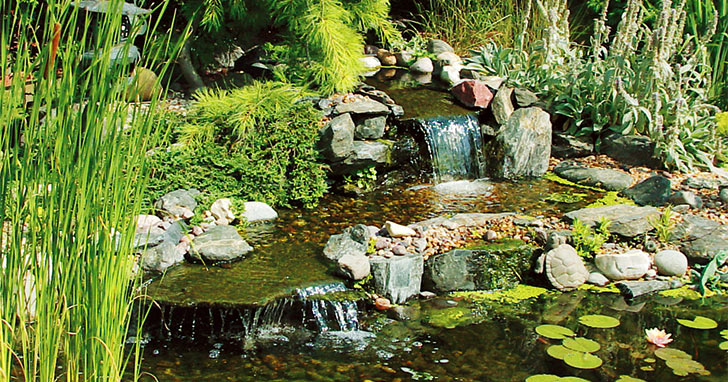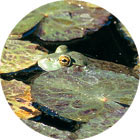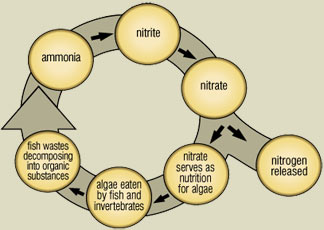
Pond ecology is the study of living organisms in a pond habitat and their interaction with the pond environment.
"Bringing nature to your own backyard" means more than filling a pond with water and adding plants and fish. It means bringing nature's methods of balancing a wetland ecosystem into your backyard as well. Building a successful pond requires gathering product information and talking to experienced pond keepers. It also entails learning how nature works to keep a healthy balance between all pond inhabitants and their environment. Use natural relationships to your advantage in planning and maintaining your backyard water garden.
What exactly is going on in a natural pond?
A pond ecosystem consists of different tiers, with the water forming the foundation of the ecosystem. These levels are dependent on the other for health and growth. In the backyard pond you create, the same relationship exists as in the natural pond. The difference lies in human intervention to provide plants, filtration, and fish to speed up the natural aging process.
A 6-tiered food chain defines your pond's ecosystem
- Bacteria, diatoms, phytoplankton, protozoa, and plants (including algae) - In a pond you create, your bio-filter gives bacteria a medium in which to grow so it can turn harmful ammonia into more neutral fertilizers (see Nitrogen Cycle, below).

- Zooplankton (daphnia and rotifers) - These tiny creatures drift through water, feeding on algae and protozoa from Tier 1.
- Larval insects, worms, leeches, snails, and insects - Members of this tier consume zooplankton as well as individuals in Tier 1.
- Amphibians (frogs, toads, salamanders, and newts) - These consume some of the lower tiers. Salamanders and newts frequent natural ponds much more often than backyard ponds, but most likely frogs will find a home in your pond.
- Fish - Most fish are omnivorous, which means they will eat just about anything. Besides any food you give them, fish will also eat all members of the lower tiers.
- Birds, reptiles, snakes, turtles, and mammals - These travelers are the connection to the surrounding environment, both for natural ponds and for your backyard paradise. Although predators may be unwanted, they do represent a vital part of the ecosystem.
How do ponds age?
All ponds begin to age the moment they are formed. As a pond ages, the nutrient level and amount of organic material increases. This aging begins when algae begin to grow, releasing oxygen during the day and carbon dioxide at night. Algae provide microscopic creatures with a food source, and as those creatures begin to thrive and die back, they become nutrients for higher orders of plant life. These plants help balance the nutrients and waste and deliver even more oxygen into the water, allowing higher levels of the ecosystem to thrive. Zooplankton feed insects and the other creatures of tier three, which in turn feed the amphibians in tier four. All of the tiers below tier five help fish thrive. Fish create waste and phosphorus (from their food) which cause plants - including algae - to grow. Thus perpetuating the cycle.
 The nitrogen cycle
The nitrogen cycle
The nitrogen cycle describes how organic waste breaks down in nature. Fish waste naturally decompose into ammonia (NH3), which is highly toxic. Nitrosomonas bacteria process the ammonia into nitrite, which is also toxic. Nitrobacter bacteria then break down the nitrite into nitrate, which is much less harmful. Nitrate is either used up by algae to complete their biological cycle, or is released into the air as nitrogen gas.
Wildlife and your pond
You can help prevent mammalian pests from visiting your pond by making sure you keep landscaping 5 to 10 feet away from water's edge. If your pond and landscaping are already in place, some other ways to discourage mammals (and birds) include:
- A floating alligator head that demonstres life-like motion with wind or water movement. Great for any water area infested with geese, ducks, egrets, cormorants, herons and other unwanted wildlife.
- An Owl Decoy has features and movement that effectively keep pond predators and garden pests away. Bird-X Prowler Owl Predator Decoy is a realistic replica of the ultimate aerial predator, the Great Horned Owl, in a dynamic hunting flight pose. Target pests include pigeons, sparrows, starlings, crows, blackbirds, grackles, seagulls, swallows, skunks, rodents, rabbits, squirrels and more.
- Netting protects fish from jumping out of your pond and predators from getting in. Netting also helps make cleanup easier by keeping leaves and debris from settling in and fouling water.
|